
(Photo by Aidan Monaghan/AMC)
At first glance, The Terror’s premise reads like a familiar tale of lost adventurers and survival in an extreme environment: In the mid-1800s, a couple of British Royal Navy ships are trapped in the ice while trying to find the Northwest Passage and face mutiny, starvation, and cannibalism. But that’s where this story, inspired by a true story and based on the 2007 novel of the same name by Dan Simmons, diverges from the ordinary.

(Photo by AMC)
Simmon’s tale puts a supernatural spin on Captain Sir John Franklin’s lost Arctic expedition of HMS Erebus and HMS Terror, as the men are hunted by the Tuunbaq, an ancient Esquimaux demon that, in this story, takes the form of a polar bear with the face of man.
The eminently bingeable series (now available to stream) leaves the nature of the demon a mystery, and the means to placate it frustratingly out of reach for the story’s protagonists.
The Terror boasts an impressive cast led by Jared Harris as Francis Crozier, Tobias Menzies as James Fitzjames, and Ciarán Hinds as John Franklin with Paul Ready as Harry Goodsir, Adam Nagaitis as Cornelius Hickey, Nive Nielsen as Lady Silence, and Greta Scacchi as Lady Jane Franklin.
Rotten Tomatoes spoke to showrunners Soo Hugh and David Kajganich about Monday’s finale, some of the season’s hanging mysteries, and a possible prequel for the series, which reportedly is being eyed as an anthology option for the network.
Kajganich also indulged us with a note on the extreme response to a clip from his upcoming film, Suspiria, which is based on the 1977 horror film by Dario Argento, is directed by Luca Guadagnino, and stars Chloë Grace Moretz, Dakota Johnson, and Tilda Swinton.

(Photo by Aidan Monaghan/AMC)
Debbie Day for Rotten Tomatoes: My first question is: What is going on with the chains on Edward Little’s (Matthew McNulty) face?
David Kajganich: We were so hopeful that people would be confounded by that, and look for answers. And the answer is even more disturbing than the question that we’ve given people in the show; it’s actually that image is based on Inuit testimony by a Netsilik woman and her son who found one of the camps and went into a tent and found a man sitting up with a bunch of gold chains sort of pierced through his face, and there was one chain that if you pulled on it, apparently this man’s head came up. And they had no explanation for it. The searchers from Britain who interviewed them had no explanation for it, and we really thought it was a very succinct way to give an audience an indication of what must have gone on in that camp in the months that have passed since we’ve seen them last: the accumulation of scurvy, lead poisoning, desperation, the psychological effects of that kind of trauma, of cannibalism. It was a very clear way to say, even though we haven’t been following these guys for the last three, four, five months, things really took a dark turn here as well.
Hugh: We put our cast and crew through a lot of interesting moments of our show, filming some interesting material, but that was probably the one day where Jared and Nive and the two gentlemen behind the camera, they were really unsettled — the makeup was phenomenal.
RT: From a viewer’s standpoint, it’s such a “W-T-F?” moment.
Kajganich: But we loved not explaining, I mean, that’s one of the things we loved about this show, is that the grammar of the show, the dramatic grammar of it, embraces ambiguity as often as it embraces insight. And so, this was one of the little ambiguity bombs we threw at the audience, hoping they would enjoy the, just, the question rather than an answer.
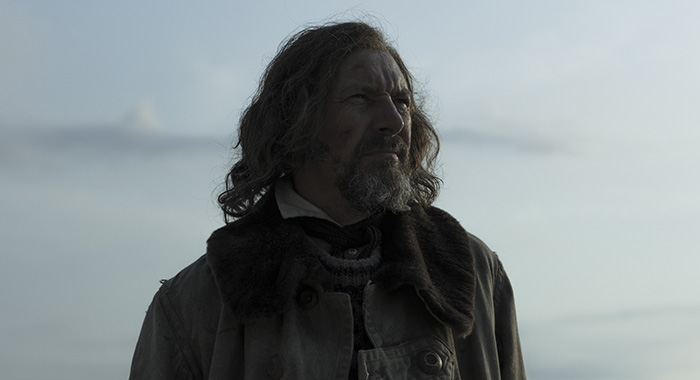
(Photo by Aidan Monaghan/AMC)
RT: I think you succeeded absolutely. One of my favorite characters has been Thomas Blanky (Ian Hart) — with the forks in the end.
Hugh: Can you imagine a more perfect death for him?
Kajganich: AMC wasn’t gonna let us use the F word in that scene, but then we lobbied so hard and said, “Look, of any show you have on the air that’s earned an F-bomb, your Victorian navy show where a guy goes out covered in forks, is there going to be a cooler opportunity to use the F word?” And they finally agreed to let us.
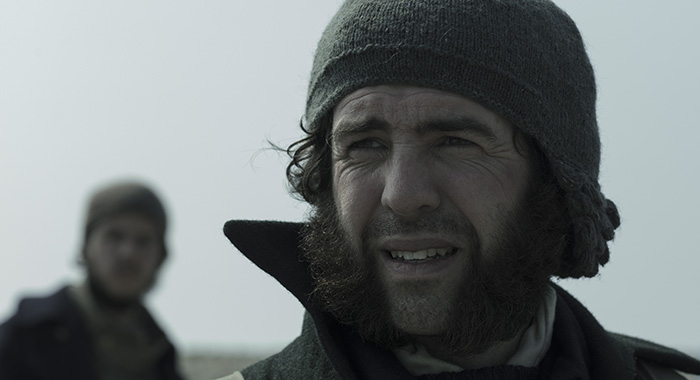
(Photo by Aidan Monaghan/AMC)
RT: After getting the show on screen, did you have a favorite character emerge, or did it stay the same from when you first started building the story for the screen?
Kajganich: That’s a tough question.
Hugh: We always had the early favorites. In the writers’ room Goodsir [pictured above] — probably from day one the whole room loved Goodsir. And Crozier’s character is so resolute — how can you not just be in awe of someone like that? What was so great about working on doing this show was that we were able to also explore secondary characters, we normally don’t get that narrative space — you know, Peglar [Kevin Guthrie] and Bridgens [John Lynch], and they don’t appear in the show that much, but when they do, the little that they do, especially near the end, they leave such an impression. I also love Lady Jane [pictured below] in episode 4 when she confronts the admiralty, that scene just, Greta, what she does there is so fantastic.
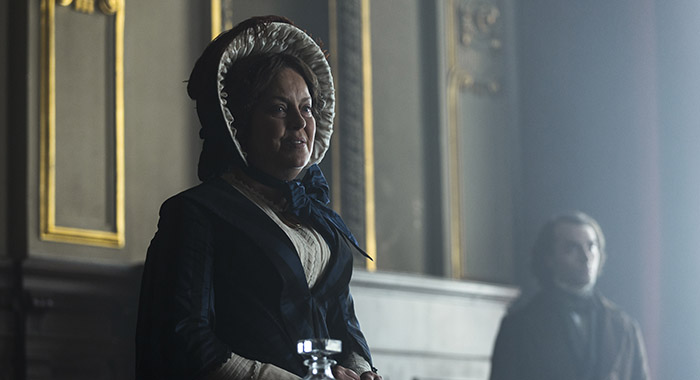
(Photo by Aidan Monaghan/AMC)
Kajganich: Watching the show now after some distance, I’ve really come to love the characters who aren’t victorious, that don’t necessarily rise to the challenge — the Hodgsons [Christos Lawton] and the Littles — and I just find them really interesting and moving to kind of watch them as they sort of fail. I don’t know, it’s an odd answer, but yeah. Like Soo said, we were just so fortunate to have this cast, because we have these secondary roles that become primary roles, or primary roles that become secondary roles, or tertiary roles that become primary roles. It’s so mixed by the end of the show that we really needed every player in this season to be outstanding, and they all were.
Hugh: And our actors were so generous, like when you have someone who’s a legend like Ciarán Hinds come to our set, and he was so generous everyone in his scenes who didn’t have speaking parts necessarily, but just making sure that everyone got their coverage, just making sure that we always had this collegial, collaborative atmosphere on set. I’ve never seen a cast bend over backwards to make sure everyone was included. It was very, very moving.
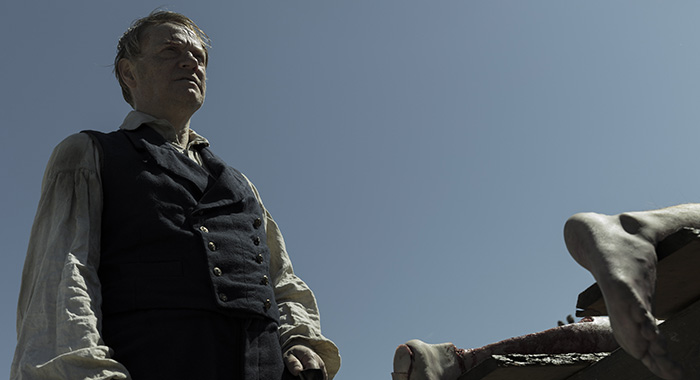
(Photo by Aidan Monaghan/AMC)
Kajganich: Jared was very often trying to give some of his lines away to other characters to make sure that they would stay in focus for the audience, it was amazing.
RT: I don’t think I’ve ever heard that before about an actor.
Kajganich: He’s the height of generosity, I mean, we couldn’t have asked for a better collaborator than Jared, in every way.

(Photo by Aidan Monaghan/AMC)
RT: I want to talk about the backstory of the fake Hickey, because I literally looked up Jack the Ripper. It turns out Jack the Ripper’s murders were happening in 1888, so he couldn’t have been on an Arctic expedition, but —
Kajganich: That’s the right idea.
RT: Can you talk a little bit about developing a backstory for him?
Kajganich: We worked with Adam to a large degree so that he would have a backstory he felt some authorship over, and he didn’t share all of it with us, which was part of what made that work. We were interested to know, in the writers’ room, at what moment each character stepped from a high adventure story into a horror story, and that’s obviously different for every character. And we knew there were going to be a handful of characters who refused, Blanky at the top of that list. He never enters the horror story; he wouldn’t dignify a horror story with his participation, ever, so he stays in the adventure story ’til the very end.
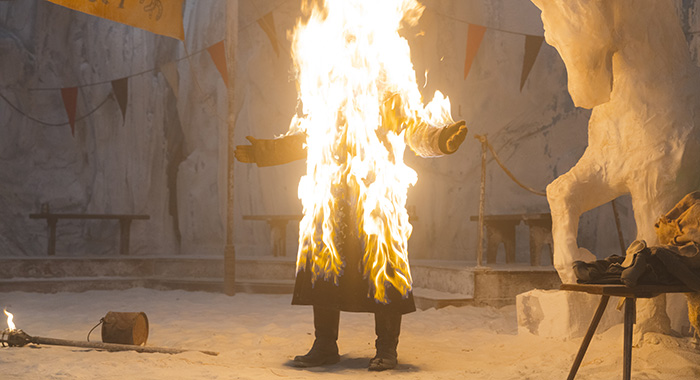
(Photo by Aidan Monaghan/AMC)
Kajganich (cont.): But we also knew we wanted a character to — Hickey being chief among them — who just already start the show in a horror show, and he’s in a survival story when we meet him and has been for years. The fact that he’s turned to rather complicated moral answers to some of life’s harder questions on someone of his class is part of what makes him interesting, but he’s somebody who’s learned a lot of coping skills for emergencies well before he ever steps on that ship, and so we wanted to have some kind of explanation, even if it’s not a definitive answer to his confidence, to his relative calm and equilibrium in the face of all of the dangers and anxieties of the show, and that seemed like a good way to articulate it.
Hugh: I hope Dave and I succeeded with Adam in eschewing some of the stereotypes of the villain role with Hickey’s character. What’s interesting about Hickey’s character is that if he has any villainy, we can call it, it comes mostly from pragmatism, and every audience member should be able to at least relate to it, they may not be able to excuse it, but we hope that they can all relate to the very very difficult, gross actions that he does, at least they can justify it.
Kajganich: I’ve been impressed by the number of people on social media that have admitted that they probably would eat a friend if pushed that far. I mean, it’s impressive.
Hugh: I would never eat you, Dave. [laughs]
RT: In the finale, Hickey admits that he killed the real Hickey in order to get on the ship, and Crozier tells him he could have just signed up. Did we learn the motivation for killing the real Hickey?
Kajganich: No. That is another thing you are not allowed to know in this.
RT: Is it just me or did the Tuunbaq look a little bit like he had Hickey’s face in the end?
Kajganich: Well, he’s meant to have a human face, so to that degree, yeah.
Hugh: But we did not put Hickey’s face on the Tuunbaq at the end.
RT: OK, good to know. Because then I was just like, Oh, it’s all a metaphor for the evil within —
Kajganich: That too, yeah.
RT: When the Tuunbaq finally dies, it’s after specifically choking on Hickey. So is that meant to be from actual poison or just a poison soul that he’s latched onto?
Kajganich: Well if you think of the long list of what the Tuunbaq’s been through — he’s been shot at by a cannon, he’s been hit by rockets, he’s been torn up inside with forks, in addition to eating a lot of lead-riddled bodies and at the top of that list is the spiritual element of this, I mean, he’s eaten a lot of Western souls that are not typically part of his diet — and then when he finally gets to Hickey and consumes that soul, that is definitely the straw that breaks the Tuunbaq’s back. It is probably so toxic that he tries to cough it up, he tries to vomit it up, but Crozier’s there to keep Hickey’s torso right plugged into his mouth. And, yeah, we definitely wanted it to feel like it was a list of things contributing to it, in the same way that there are a list of things contributing to the men’s deaths, but sure, at the top of that list, comes the horrible, curdled soul of Hickey.
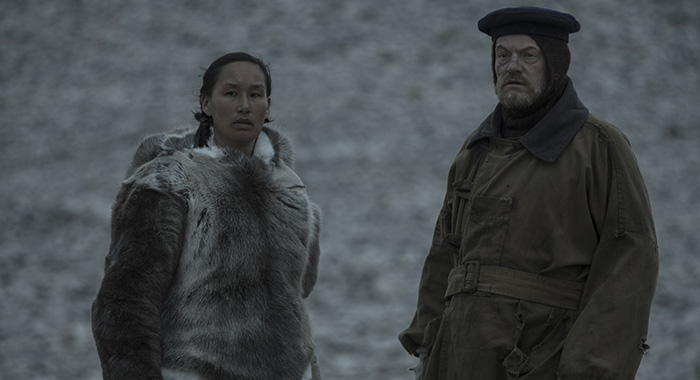
(Photo by Aidan Monaghan/AMC)
RT: I haven’t read the book, can you talk a little bit about some of the changes in the adaptation for screen?
Hugh: It’s a great book, you should read it.
Kajganich: It’s fantastic, and hopefully the show is as satisfying on its own terms as the book is on its, and like Soo said, it’s a fantastic read, but the biggest change we made was around the character of Lady Silence, Silna. In the book, she does not have a tongue from the beginning, so you never hear her speak out loud, and at the end of the book, she marries Crozier and has his children, and so we thought, since we have 10 hours to really explore these characters, that we wanted to try to take on the Netsilik characters in the show more on their own terms than having them strictly be subservient to the stories of the white characters, the British characters in the show.
And once we’d decided that, in the writers’ room it was very easy to start doing the kind of research we would need to build out a full character with a full set of concerns that weren’t just in service to the main Western characters. And that was a great process, and, I think, yielded a really unexpected equivalent for Crozier. When I think about Lady Silence’s character, by the end of the show she and Crozier are kind of peers in the sense that they are both captains, so to speak, who have lost their ships and have to sort of pay the consequences of that. And I think it’s a wonderful surprise that the show has up its sleeve over the course of this season, in that you have a character who seems so much an outsider, even to the tone of the show, but over the course of 10 episodes, we slowly bring her more and more and more into prominent focus until she’s Crozier’s equal at the end.
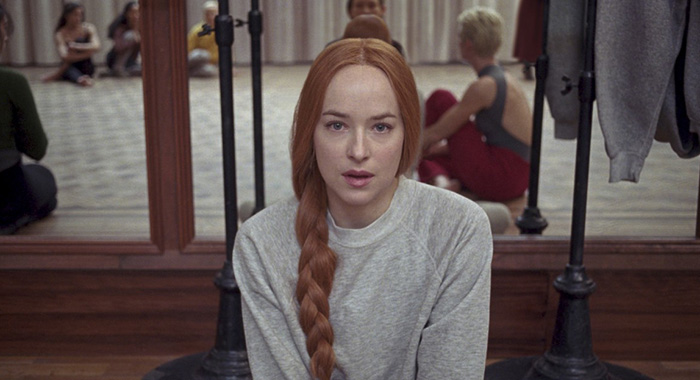
(Photo by Amazon Studios)
RT: David, I did want ask you about the CinemaCon reception to the Suspiria footage. Were you there? And what was your response to the response?
Kajganich: I was meant to go, and at the last minute couldn’t, and I’m sorry I couldn’t go, because the idea of standing there while 2,000 people tried not to throw up their lunch would have been a great moment. I knew they were screening that clip, and Luca wanted me to be sort of in the room to see the reaction, ’cause we’ve not shown it, really, to anyone that wasn’t sort of a part of the making of the film — or at least not many people. And so that screening, that little bit is a very effective promise of what’s coming in the film when people see it at Venice [Film Festival], or when it’s released in November. It’s a crazy, crazy piece of cinema.
RT: Great, I look forward to it. And I just want to put it out there that if there was a The Life and Times of Tuunbaq prequel to The Terror, I would watch it. I’m just saying.
Hugh: We would do that.
The Terror is available to watch on amc.com and the AMC app for iOS, Apple TV, Android, Windows, Fire Tablets, Roku, and Xbox One.; also on iTunes, Google Play, Amazon, and Xbox and through video on demand through your cable provider.